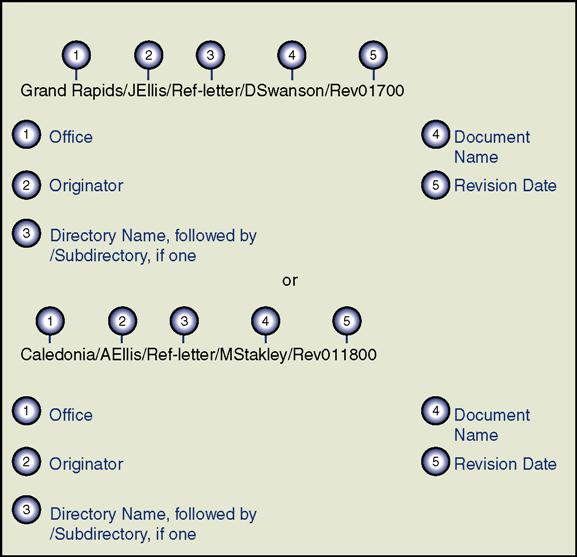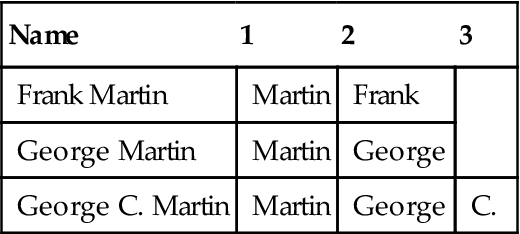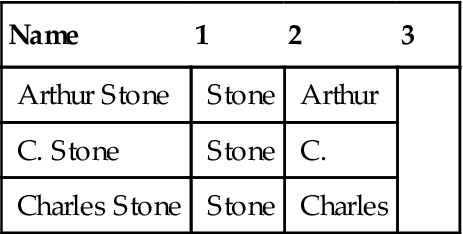Storage of Business Records
LEARNING OUTCOMES
Vast amounts of information are generated in the dental office each day. The idea of a paperless office sounds exciting, but it has proved to be a myth. Reality dictates that traditional methods of record storage will be used for some time. In Chapter 7, disposition is identified as the final stage of a dental record—either destruction or storage. The administrative assistant is responsible for managing and maintaining records, both paper and electronic files. This chapter discusses records storage. A sound understanding of records management and the indexing rules associated with records storage will continue to be an essential skill for the administrative assistant.
A dental office produces many kinds of information, including clinical and financial records, radiographs, and diagnostic models. Inability to find a document quickly is frustrating and can often delay a decision, diagnosis, or payment. Such delays can be costly and stressful.
A record is stored information on any media created or received by the office that is evidence of its operations or that has value requiring its retention for a period of time. For example, information may be:
• Written and recorded on paper as in a patient’s clinical or financial record
• Written forms such as an employee records
• Any written and recorded information on some type of electronic form or microform
• An oral record that captures the human voice and is stored on DVD or other electronic storage media.
• Radiographs, video, digital photographs, stored on DVDs or other media
Records are assets to the dental practice. They provide legal value by providing evidence of treatment and business transactions. Records may provide information of articles of incorporation, real estate, and contracts. Records provide information on day-to-day operation of the practice and historical evidence of treatment, employee data, and financial activity. Thus the maintenance of these records becomes a major responsibility of the administrative assistant—to ensure a smooth flow of the practice as well as a safe and secure practice.
To many administrative assistants, filing is one of those dreaded, procrastinated, routine jobs done when the administrative assistant can “get around to it” or “has the time.”
Anyone with office experience knows that records must be readily available. Wise planning can save a tremendous amount of time and effort. The heart of any professional office is its filing system. Business office files should not be a place to put materials, but rather a place to find materials. A systematic plan for storage, retrieval, transferring, protection, and retention must be established. When planning for the office files, consider ease in retrieval, confidentiality, and safety. The needs of the office, the size of the dental practice, and the space available for equipment are determining factors in establishing an efficient filing system.
PREPARING RECORDS FOR FILING
Basic Steps
Certain routines should be followed in preparing materials for filing: (1) set aside some time each day or every few days for filing paper records; (2) keep papers or records to be filed in a basket marked to be filed; (3) file electronic records immediately in the appropriate electronic folder. Make backup copies of all electronic files as they are completed.
Before mastering the different filing systems, it is necessary to learn and understand some basic steps, which are generally done in the order of inspecting, indexing, coding, sorting, and storing:
• Indexing: Determine under which caption or name an item is to be filed. Indexing is a mental process that requires making a decision. For instance, if the record is a receipt for a payment that was just made from the dentist’s checking account, the administrative assistant must decide into which file to place the receipt. If files are organized by subject, file the receipt under the subject to which it pertains (e.g., a receipt for an electric bill might be filed under “utilities” or “electricity”). For a patient’s clinical record, use an alphabetical system and break down the name into first, second, and third units to consider for filing.
Electronic records are indexed by determining in what directory the file should be located and by following a uniform procedure for naming the files. Do not name electronic files with characters or words that do not identify the subject of the record.
• Coding: Once the caption or title of the record has been determined, assign a code by highlighting, typing, or writing a caption on a paper record or by giving the electronic file a name. On an electronic record, this is done by creating a descriptive file name and including it on the document under the initials of the creator. If an electronic file also exists in paper form, the file name on the document allows for quick, easy retrieval. Examples of coding are shown in Figure 8-1. The clinical record is coded with the patient’s name, and the electronic document is coded with the name of the originator and other important information about the document.
Two other aspects of document storage, cross-referencing and retrieval, deserve special consideration, as follows:
1. Cross-referencing alerts staff members that a record normally kept in a specific location has been stored elsewhere. A cross-reference can be provided by making a copy of the record and filing it in the referenced file with a note that it is a copy, or a cross-reference sheet can be put in the file. A cross-reference sheet contains the name of the document, the date it was filed, a brief description of the subject of the record, and the places where the record could be found. This type of cross-referencing is often found in a library card catalog.
Although it does not commonly happen with patient clinical charts during routine treatment, a record may need to be removed from a file and used in another location for consultation or study. In such cases, the out-folder should denote the area to which the record has been taken. Electronic filing appears to lessen the chance for a lost record, but loss can occur when coding is done incorrectly and the record is not placed in the correct file.
Records Retention
It is not cost-effective to maintain unnecessary records and filing cabinets. Many records in the dental office are retained in accordance with state statutes. If the practice is large, a retention schedule may have been developed for various documents. If the office does not have a retention schedule, the administrative assistant should check with the dentist before deciding how documents should be transferred or destroyed. The National Archives and Records Service, a federal agency, has produced a helpful reference, Guide to Record Retention Requirements. It is available from the Superintendent of Documents, U.S. Government Printing Office, Washington, DC 20402.
Retention and destruction of files have taken on additional importance since the federal Revised Rule 26 of the Rules of Civil Procedure was approved in December 1993. This rule requires organizations to make available all relevant records that must be kept in compliance with prevailing statutes and regulations. Delay or failure to find information makes an office vulnerable to financial loss and adverse legal judgments.
CLASSIFICATION OF FILING SYSTEMS
Five Basic Systems
The five basic classification systems of filing are the alphabetical system, the geographical system, the numerical system, the subject system, and the chronological system. All these methods except the chronological system basically apply alphabetical procedures. The method used in a dental office depends on the type of practice, but it is not uncommon to use several of these methods for various types of filing.
Selecting the Appropriate Filing System
Alphabetical System
In an alphabetical filing system the arrangement of names appears in sequence from A to Z. The alphabetical filing system accounts for about 90 percent of the filing a person is likely to perform and can be applied to various captions. Standard rules exist for alphabetizing correctly. Box 8-1 illustrates alphabetical indexing rules applied to a variety of situations.
Stay updated, free dental videos. Join our Telegram channel

VIDEdental - Online dental courses


 Practice Note
Practice Note Practice Note
Practice Note
 Practice Note
Practice Note Practice Note
Practice Note



